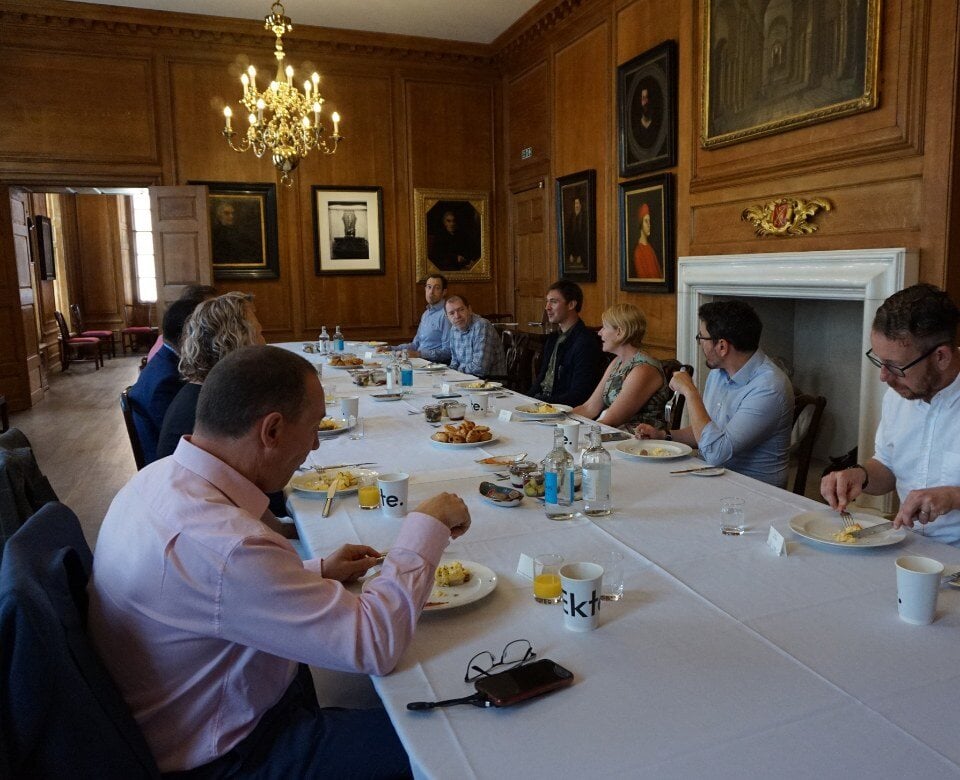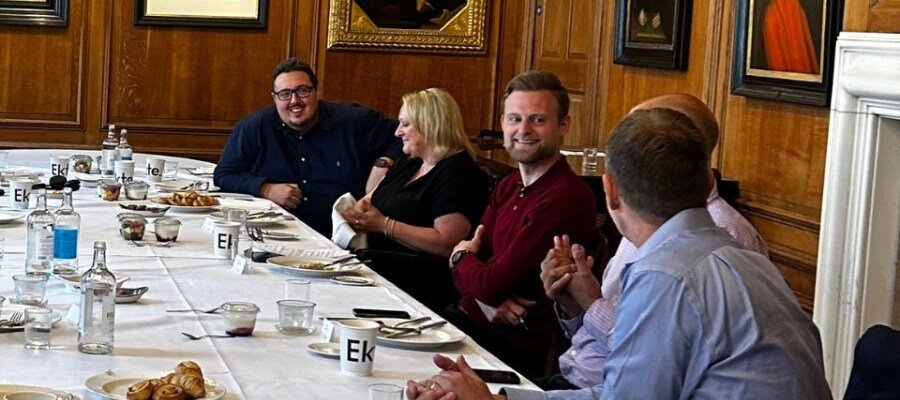
Embracing digital disruption: Navigating the future of business

HotTopics Editorial Team
Embracing digital disruption
How are businesses positioning themselves to be as adaptable as possible, encouraging innovation, and driving forward-thinking strategies for future success?
This HotTopics Food for Thought experience, in partnership with Tata Communications, and hosted at St Paul’s Cathedral, London, invited technology and digital leaders across the UK to debate this key industry topic over breakfast.
Food for Thought lunches are exclusive gatherings, tailored for a select group of leaders, providing a unique space to discuss topics vital to the C-suite. Keep abreast of what executives are exploring as they navigate the future of business, in this article round-up, leveraging new strategies to stay ahead of the curve and positing the questions any leader should be asking themselves today.
With 25 leaders joining HotTopics and Tata Communications, this experience was split into two groups. Group 1 was led by Peter Stojanovic, Editor, HotTopics; Group 2, by Doug Drinkwater, Editorial and Strategy Director, HotTopics. You can read a summary of Group 1's debate, below.
Embracing digital disruption: Group 1
- Bridging the digital divide: managing asymmetrical transformation
- The qualities of leadership
- People, process and pragmatism
- Group 2
Bridging the digital divide: Managing asymmetrical transformation
It is one thing to react to digital disruption, quite another to embrace it as part of how we now work.
For technology leaders and their businesses, the latter will soon be the only way for them to succeed. What differentiates the reactive organisation from the adaptive? It’s people. Naturally, therefore, this Food for Thought breakfast, from HotTopics in partnership with Tata Communications, began there.
Successive digital transformations are impacting teams asymmetrically, we heard. Where some individuals or functions are responding well to new, digital solutions and adapting accordingly, others are not.
One C-suite executive reflected on how her new remit of reorganising global team productivity has seen her find “pockets of brilliance” alongside “traditionalists who risk being left behind”.
Context is key, however. This business is a global leader in oil and gas, and employs a diverse workforce of talent, from software engineers to geophysicists and bio-scientists. These specialists are in no danger of having their roles digitised (yet). Still, it does highlight that the very pace of change is evolving parts of an organisation much faster than others, driving a digital wedge between functions that “is proving harder and harder to plug”.
Consider the definition of a digitally mature business. Is it one that enjoys a high, uniform level of digital competence across all its business units, or one whereby a company is pragmatically relying on departments to set their own standards and prioritise working better together? What sounds like a theoretical question is one that strikes at the heart of a C-suite leader’s challenge today.
For example, some leaders discussed how they empower teams digitally whilst reducing risk.
“We have a sort of digital-soft-play-area. One thing we realised is that demystifying the constant change in digital solutions—the pace of innovation—is a simple way to encourage experimentation and, most importantly, confidence.”
The “area” was, in fact, a protected space within the IP of the business that encouraged team members to enjoy technology. It initiated a change in momentum as it were, a forward movement of teams seeking better ways of working — what executives around the table called an “energy” they look out for when designing teams around new transformation projects. This grows interested employees. And this growth of the talent pool—of available individuals capable of pushing change forward—in turn helps the executive team achieve their targets.
This promotes trust across the team and within leadership. More importantly, it promotes trust in change itself, which is critical for navigating and embracing digital disruption, we heard.
The qualities of leadership
A natural segue to the role of leaders then occurred.
A new CEO is an excellent opportunity to reset a digital strategy, came a pithy reply, but, interestingly, navigating the future of business may require more attention on failures.
“Failure is an opportunity to learn. We’re looking at how we can codify learning into the process so we can begin to celebrate failure.”
Although leaders set the culture of a company, ‘celebrating failure’ is still a controversial method for some, particularly in certain regions. The industry is still reluctant to adopt this very start-up-like anthem—and with good reason. In times of tough market conditions, downsizing teams is a go-to choice for efficiency drives. The first people to go are those not seen as directly improving the bottomline.
This is the experience in banking, currently. The sector shed 60,000 jobs globally in 2023. Workforces across the sector are reducing at an average five percent from 2022 levels. Compounding this sense of unease for teams is the high levels of regulation to which they must adhere. Taken together, there is a “fear factor, a reticence to putting hands up and volunteering for new projects and initiatives that may not succeed.” This kickstarts a downward spiral: fewer people contributing to cutting-edge work precipitates shedding the workforce.
At one point during the debate, leaders agreed that leadership today is about ensuring good team chemistry as an indirect approach to higher levels of innovation and growth. Their key challenge for 2025 is to achieve this despite external pressures such as inflation and cost-cutting and internal hang-ups in the form of ennui.
That does not mean economic disruption is always negative. Some leaders personify the adaptability they espouse and try to see the benefits.
“Tough macroeconomic environments force us to work more efficiently and reduce waste—in our investments, our workloads and more,” said one leader.
Another considered personality drivers: “We need disruptive periods to encourage us to work better. I like [disruption]! I see it as a great way to reconsider how we work, but not everyone thinks this way, and it’s half my job to convince the rest of the team this.”
If that seems like a high percentage, later in the debate these technology leaders agreed that their remits involve “80 percent people, and 20 percent solving strategic challenges”.
It is quite a change in dynamic for executives whose track records include software development, engineering, PhD mathematics, deep learning and more. For the future of digital leaders, analogue humans and team dynamics are its core foci - as we touch upon later in this report.
People, process and pragmatism
Tata Communications and Jaguar Land Rover have deployed a cloud-first, software-defined wide area network (SD-WAN) technology across all 128 sites of the automaker. The capability will allow real-time connectivity between JLR's global headquarters in Coventry, UK, and its plants, warehouses, sales centres, data centres and cloud services.
Styled as a 'digital fabric', it comprises Tata Communications’ agile infrastructure, platforms and managed services, that will help integrate JLR's systems, workforce, suppliers, stakeholders and customers across the globe, delivering a seamless flow of data to enrich key aspects of the business ecosystem.
This focus on a more interdisciplinary IT and business environment comes at a good time. Technology leaders have seen how siloed digital functions—even when transformed—stymie growth. During this first debate, this conversation revealed that leaders are looking to reconfigure their structures to better benefit individual learning, team collaboration and cycles of innovation. To the point of digital fabric, that doesn’t necessarily put the focus on IT.
“Digital maturity is rethinking your structure so that it isn’t so IT-dominated.”
We have all heard the adage of having a hammer in one’s hand makes everything seem like a nail. In digital terms, this can be applied to the hype cycles of technology. Perhaps finally, leaders seem to be resisting these shiny new labels and instead focusing on the “boring side” of people and processes.
A counterintuitive consequence of digital maturity is that the focus switches to these analogue issues. It left much food for thought for leaders around the table. Top of mind? When navigating the future of business because of, or despite, digital disruption, how they solve issues within the non-digital elements of the organisation will dictate not how they survive, but if.

Embracing digital disruption: Group 2
- Leading change in multi-speed organisations
- Leadership, accountability and a mandate for investment
- The risk of multi-speed organisations, and shadow IT
- Culture and communication can sustain growth
- The AI wave comes with familiar trappings
Leading change in multi-speed organisations
Technology executives are constantly asked to perform their own hi-wire act, carefully balancing the day-to-day needs of the organisation with the insatiable appetite for change; supporting new M&A initiatives, entries to new markets, the development of new services and adherence to new legislation.
With digital and IT investments continuing to soar, even amid a relatively staid economic environment, technology executives have been stretched in different directions - one-part change agent, another-part operational lead.
This expanding remit and required adaptability, as discussed earlier, has been in no small part due to the increasing democratisation of technology and rising line-of-business technology budgets.
Finance, HR, marketing and other line-of-business departments have taken to tech in new ways, the boardroom has become enamoured with AI’s continued bloom, and yet many technology leaders find themselves standing-up these new services while tending to dated (and customised) legacy environments – and internal attitudes to change too.
Leadership, accountability and a mandate for investment
To drive sustained change – always a challenge in lengthy and costly transformation programmes, the senior executives here spoke most passionately of the need for that authoritative voice in the boardroom.
CIO and CTO roles can be lonely, siloed and therefore there continues to be a danger of falling back into ‘run IT’; basement-style IT departments delivering for business departments, rather than collaboratively alongside them.
Tech executives must quickly establish their credibility, communicating a clear and compelling vision for the benefits of the agreed change, and using that storytelling to get funding from non-technical business stakeholders. They must also break through change fatigue of teams, who may have been through multiple transformation cycles before.
Relationships matter; one CTO here spoke of the need to keep your COO and CEO onside, and the risk of falling foul of departmental managing directors with their own remits and ideas – another remarked the need for ‘quick wins’ within the first 90 days to gain authority and a mandate for investment.
Tenacity, and a collaborative mindset, are other non-negotiables in the race for disruption.
“You need the soft skills in terms of taking people on the journey. But a lot of the transformative CIOs I've worked with have said; we're going to mandate this for five years, we're going to get it done and we're going to drive it through the business,” said one executive in telecommunications.
The risk of multi-speed organisations, and shadow IT
A decade ago, the big consultancies ushered in a concept of IT operating at multiple speeds. The premise was that the established IT business units worked too slowly for the digital demands; as such, they recommended that these teams should be split into new functions.
The advent of DevOps, agile, opex expenditure and differing models of cloud adoption, in conjunction with a pandemic which expedited time-to-value expectations, put paid to such an idea. But some could argue the dregs of the concept remain. After all, for all the talk of scalable MVPs and agile multi-disciplinary teams, cumbersome, big-bang projects, and dated team attitudes, still remain. Many CIOs attest that people change, and the dreaded “this is how it’s always been done”, is harder than anything to do with technology or process.
For larger organisations, this pull behind the new and the old can result in a fragmented architecture, one riddled with inefficiency, high maintenance and lacking in business agility.
One group CTO explained how this manifests at an organisation-wide level. He works at a 100-year-old watchmaker which has grown from £300m to £1.8bn in revenue since floating on the London Stock Exchange.
“We're very conservative and legacy. AI and everything else is not really of any interest to the organisation – there's a view that most of our customers buy one watch and you don't see them again. So they're not interested in the total lifetime value of the customer, for example.
“The challenge is that the US is now half our business ... .They're now acting like a startup…so their expectations for technology are very different. For me at a group level, a new role, it’s about trying to get the best of both.”
For this executive, this disparity reinforces the need for introducing common standards and platforms, given the current decentralised model of largely custom-built systems is not sustainable.
Yet this issue of implementing the digital guardrails is not without caution. C-suite executives told HotTopics that too much governance and IT returns to the days of basement IT; too little and a chaotic shadow IT runs amok, making rationalisation, system visibility, risk management and data governance increasingly critical.
In one such example at this Food for Thought lunch, one executive shared how approximately £20-25 million of the firm’s £80-90 million IT spend was outside IT and thus initially unaccounted for.
Culture and communication can sustain growth
The appetite for digital change can differ wildly across the organisation; inertia, digital literacy, dexterity and culture all impact where digital sits in the priorities, and the ethos or principles of the organisation.
In HotTopics’ inaugural C-Suite Digital Baseline study, which surveyed 100 tech executives, 39 percent described their digital maturity as ‘emerging’—with some digital initiatives in place but inconsistent adoption. Another 37 percent described it as ‘established’, with moderate digital capabilities and ongoing efforts to enhance integration and efficiency.
For these executives, this appetite comes back to the importance of being aligned on objectives and culture, but also ensuring clear communication on both sides.
“I was their first CDIO….the challenge for me is [the business] understanding the maturity of an organisation; why you need what you need, why you can't just develop something yourself; what you need to think about with enterprise technology” said a utilities CDIO, further explaining the need to scale to eight million homes would require “grown-up thinking” on investment, standards and cybersecurity.
For another CIO, in the financial services industry, it comes back to collaboration internally - the tech executive doesn’t necessarily need to sit through every MarTech (marketing technology) business case, but he’ll require their support when deeper technology modernisation is required to drive business-wide transformation.
This understanding also works from a customer perspective. The CTO of an automotive firm described their belief in ‘digital convenience’; the need to balance the human touch of roadside repair with digital tools, but not leaning so far as to alienate customers who may feel disconnected when having to rely too much on apps or digital channels.
The AI wave comes with familiar trappings
Digital transformation’s next wave is artificial intelligence - already the topic of conversations in boardrooms, and not-so-discreetly being integrated into all levels of the tech stack. According to Gartner, spending on AI technologies is expected to rise from $124 billion in 2023 to $297 billion by 2027.
Despite this, as evidenced at other recent HotTopics events, getting internal business alignment is proving to be challenging. And that’s a problem given organisations are already laser-focused on ROI, itself far from straightforward according to a recent report from Goldman Sachs.
One executive in this session explained how, when the conversation with CIOs and CTOs turns to using AI for generating revenue, a slew of complexities emerge; after all, AI requires significant investment, a clear mandate top-down and cross-function and a deep integration and cleansing when it comes to legacy IT infrastructure and data modernisation respectively.
“It then goes in the ‘too hard’ bucket,” said one exec, adding the switch-back to trying to save money – and reinforcing once again the value of good communication and storytelling.
As outlined in this whitepaper, C-suite executives navigating digital disruption must tackle challenges on multiple fronts. They need to empower their teams, foster pockets of experimentation, and scale successful initiatives, all while ensuring the organisation moves cohesively in one direction, even if at varying speeds.
Above all, adaptability is crucial; clear and effective communication of change is essential to aligning business needs with digital investments.
The Hyperconnected Business:
HotTopics and Tata Communications are proud to launch the Hyperconnected Business initiative, a tailored community for CIOs, CTOs, and senior executives to explore modern digital infrastructure. Discover more about how we are redefining business with modern digital solutions.
SUBMIT A COMMENT
RELATED ARTICLES
Success isn’t metrics, it’s people: Leadership and life with Sarah Roberts
14 Jan 2026
Join the community
To join the HotTopics Community and gain access to our exclusive content, events and networking opportunities simply fill in the form below.
